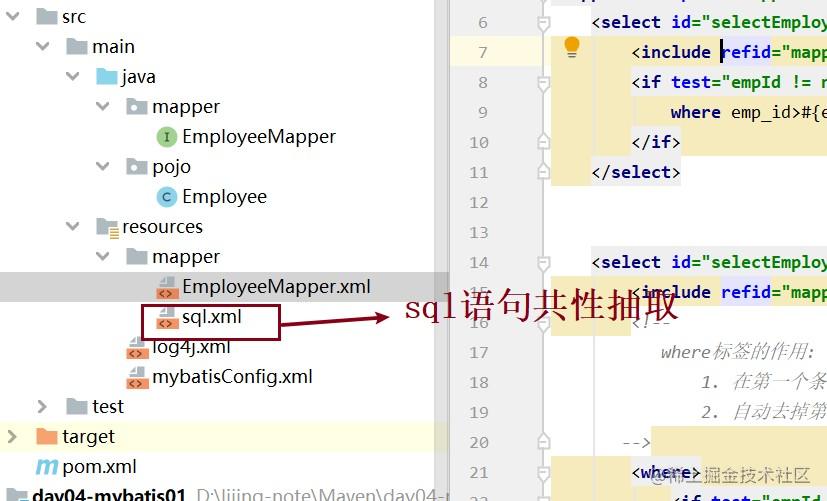MyBatis 动态SQL全面详解
前言
前面mysql都是通过静态sql进行查询的,但是如果业务复杂的时候,我们会遇到引号问题,或者多一个空格,这就使得sql代码编写错误了,所以为了解决这个问题,我们有了动态sql。
Mybatis框架的动态SQL技术是一种根据特定条件动态拼装SQL语句的功能,它存在的意义是为了解决拼接SQL语句字符串时的痛点问题。具体是通过标签来实现的。
动态sql
1.先看一下模块目录结构
在类路径的resources下的mapper包下创建sql.xml文件(共性抽取)

2.物理建模和逻辑建模
这里省略物理建模步骤,要求数据库的表与pojo类要对应。
package pojo;import lombok.AllArgsConstructor;import lombok.Data;import lombok.NoArgsConstructor;@Data@AllArgsConstructor@NoArgsConstructorpublic class Employee { private Integer empId; private String empName; private Double empSalary;}<?xml version="1.0" encoding="UTF-8"?><project xmlns="http://maven.apache.org/POM/4.0.0" xmlns:xsi="http://www.w3.org/2001/XMLSchema-instance" xsi:schemaLocation="http://maven.apache.org/POM/4.0.0 http://maven.apache.org/xsd/maven-4.0.0.xsd"> <modelVersion>4.0.0</modelVersion> <groupId>org.example</groupId> <artifactId>day03-mybatis02-dynamic</artifactId> <version>1.0-SNAPSHOT</version> <packaging>jar</packaging> <dependencies> <dependency> <groupId>org.projectlombok</groupId> <artifactId>lombok</artifactId> <version>1.18.8</version> <scope>provided</scope> </dependency> <!-- Mybatis核心 --> <dependency> <groupId>org.mybatis</groupId> <artifactId>mybatis</artifactId> <version>3.5.7</version> </dependency> <!-- junit测试 --> <dependency> <groupId>junit</groupId> <artifactId>junit</artifactId> <version>4.12</version> <scope>test</scope> </dependency> <!-- MySQL驱动 --> <dependency> <groupId>mysql</groupId> <artifactId>mysql-connector-java</artifactId> <version>5.1.3</version> <scope>runtime</scope> </dependency> <!-- log4j日志 --> <dependency> <groupId>log4j</groupId> <artifactId>log4j</artifactId> <version>1.2.17</version> </dependency> </dependencies></project>
5.sql共性抽取文件
在类路径resources下的包mapper下创建一个sql.xml(因为我们sql是要写在映射文件中,自己本身也是映射文件,所以需要写在mapper下)。到要用的时候,在映射路径文件中需要用到这个sql语句的地方加入 <include refid="mapper.sql.mySelectSql"></include>。
<?xml version="1.0" encoding="UTF-8" ?><!DOCTYPE mapper PUBLIC "-//mybatis.org//DTD Mapper 3.0//EN" "http://mybatis.org/dtd/mybatis-3-mapper.dtd"><mapper namespace="mapper.sql"> <sql id="mySelectSql"> select emp_id,emp_name,emp_salary from t_emp</sql></mapper>
6.mapper接口
一共有七个方法
package mapper;import org.apache.ibatis.annotations.Param;import pojo.Employee;import java.util.List;public interface EmployeeMapper { //根据员工的empId查询大于该empId的所有员工,如果empId为null,则查询全体员工 List<Employee> selectEmployeeListByEmpId(Integer empId); /** * 查询大于传入的empId并且工资大于传入的empSalary的员工集合,如果传入的empId为null,则不考虑empId条件 * 传入的empSalary为null则不考虑empSalary的条件 */ List<Employee> selectEmployeeListByEmpIdAndEmpSalary(@Param("empId") Integer empId, @Param("empSalary") Double empSalary); /** * 根据empId更新员工信息,如果某个值为null,则不更新这个字段 */ void updateEmployee(Employee employee); /** * 根据emp_id查询员工信息,如果0<emp_id<6,那么就查询所有大于该emp_id的员工,如果emp_id是大于6,那么就查询所有小于该emp_id的员工 * 如果是其它情况,则查询所有员工信息 */ List<Employee> selectEmployeeList(Integer empId); /** * 添加员工信息 */ void insertEmployee(Employee employee); /** * 批量添加员工集合 */ void insertEmployeeList(@Param("employeeList") List<Employee> employeeList); /** * 根据员工的id集合查询员工集 */ List<Employee> selectEmployeeListByEmpIdList(List<Integer> idList);}Dao接口的方法为:List<Employee> selectEmployeeListByEmpId(Integer empId);
静态sql:
<select id="selectEmployeeListByEmpId" resultType="Employee"> <include refid="mapper.sql.mySelectSql"></include> where emp_id>#{empId}</select>where
目标:
- 查询大于传入的empId并且工资大于传入的empSalary的员工集合
- 如果传入的empId为null,则不考虑empId条件
- 传入的empSalary为null则不考虑empSalary的条件
Dao接口方法:
List<Employee> selectEmployeeListByEmpIdAndEmpSalary(@Param("empId") Integer empId, @Param("empSalary") Double empSalary);
用if标签的动态sql:
<select id="selectEmployeeListByEmpIdAndEmpSalary" resultType="Employee"> <include refid="mapper.sql.mySelectSql"></include> where <if test="empId != null"> emp_id>#{empId} </if> <if test="empSalary != null"> and emp_salary>#{empSalary} </if>where和if的动态sql:
<select id="selectEmployeeListByEmpIdAndEmpSalary" resultType="Employee"> <include refid="mapper.sql.mySelectSql"></include> <where> <if test="empId != null"> emp_id>#{empId} </if> <if test="empSalary != null"> and emp_salary>#{empSalary} </if> </where></select>- 在第一个条件之前自动添加WHERE关键字
- 自动去掉第一个条件前的连接符(AND、OR等等)
trim
trim是修建的意思,其实就是去头去尾,这里还是根据上面那个方法
trim的动态sql
<select id="selectEmployeeListByEmpIdAndEmpSalary" resultType="Employee"> <include refid="mapper.sql.mySelectSql"></include> <trim prefix="WHERE" prefixOverrides="AND|OR"> <if test="empId != null"> emp_id>#{empId} </if> <if test="empSalary != null"> AND emp_salary>#{empSalary} </if> </trim></select>Dao接口方法:void updateEmployee(Employee employee);
我们先用上面的trim标签来解决一下这个问题,
trim的动态sql:
<update id="updateEmployee" > <trim prefix="set" prefixOverrides=","> <if test="empName!=null"> emp_name=#{empName} </if> <if test="empSalary!=null"> , emp_salary=#{empSalary} </if> </trim> where emp_id=#{empId}</update>set标签的作用:
- 自动在要修改的第一个字段之前添加SET关键字
- 去掉要修改的第一个字段前的连接符(,)
choose、when、otherwise
目标:
- 根据emp_id查询员工信息,如果0<emp_id<6,那么就查询所有大于该emp_id的员工
- 如果emp_id是大于6,那么就查询所有小于该emp_id的员工
- 如果是其它情况,则查询所有员工信息
Dao接口方法:List<Employee> selectEmployeeList(Integer empId);
动态sql
<select id="selectEmployeeList" resultType="employee"> <include refid="mapper.sql.mySelectSql"></include> where <choose> <!--<是<号的转义字符--> <when test="empId>0 and empId<6"> emp_id>#{empId} </when> <when test="empId>6"> emp_id<#{empId} </when> <otherwise> 1==1 </otherwise> </choose></select>- 如果某一个when的条件成立,则不会继续判断后续的when
- 如果所有的when都不成立,则会拼接otherwise标签中的内容
foreach
目标1:批量添加员工信息
Dao接口方法:
void insertEmployeeList(@Param("employeeList") List employeeList);
1.动态sql
<insert id="insertEmployeeList"> insert into t_emp(emp_name,emp_salary)values <!--collection标签可以写list,collection, 或者自己自己定义参数名@Param("employeeList") List<Employee> employeeList--> <foreach collection="employeeList" separator="," item="emp"> (#{emp.empName},#{emp.empSalary}) </foreach></insert>Dao接口
List selectEmployeeListByEmpIdList(List idList);
2.动态sql
<select id="selectEmployeeListByEmpIdList" resultType="employee"> <include refid="mapper.sql.mySelectSql"></include> <foreach collection="collection" item="id" separator="," open="where emp_id in (" close=")"> #{id} </foreach></select>
更多相关文章
- MySQL系列多表连接查询92及99语法示例详解教程
- Android(安卓)- Manifest 文件 详解
- Android的Handler机制详解3_Looper.looper()不会卡死主线程
- Android最全面试题库(转)
- Selector、shape详解(一)
- android2.2资源文件详解4--menu文件夹下的菜单定义
- Android发送短信方法实例详解
- Android(安卓)读取资源文件实例详解
- 详解Android中的屏幕方向
